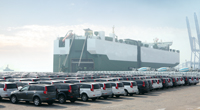 A wise man once said that the automotive industry is the industry of industries. The automotive ecosystem is vast, consisting of a complicated network of tier suppliers, 3PLs, OEMs, distributors, dealers and retailers, and not least customers. Across that network parts are being borrowed from all over.
A wise man once said that the automotive industry is the industry of industries. The automotive ecosystem is vast, consisting of a complicated network of tier suppliers, 3PLs, OEMs, distributors, dealers and retailers, and not least customers. Across that network parts are being borrowed from all over.
After the steady recovery from the 2008 recession, the automotive industry is finally getting back on track and getting to grips with the future. Consumers are becoming more demanding and manufacturing is becoming more difficult because of the high complexity and high volume. This was discussed during a webinar hosted by supply chain and retail services provider, JDA Software entitled, ‘Meeting the New Normal in light of increasing demand and supply volatility’.
Amitabh Kumar, senior director, industry strategy at JDA Software (pictured), explained some of the megatrends in the automotive industry and how they will affect manufacturers. China has emerged as the single largest producer and consumer, which will mean an increasing cost pressure, a shift in the centre of gravity for the industry and a focus on a consumption orientated economy for automotive companies. In recent years the growth in connected cars has exploded, so vehicles are now more like computers than machines. While this is an exciting time, the rise in technology will add increasing complexity to the supply chain, and manufacturers will need to be able to manage big data processing, according to Kumar.
Along with the rise in technology inside vehicles, consumers are now using technology to influence their purchasing decisions, he said. Customers are doing all their research and comparisons online, before going to a dealer for the final purchase. This is expected to change even further as more vehicles are bought online too. For the industry, the role of the dealership is changing, and companies need to focus on creating a good digital customer experience. The accuracy of inventory data is also essential.
Inventory data is also important to manage the volatility of demand. Models have more variants than ever, making forecasting and maintaining a good level of customer service difficult. As product variants are on the rise, customers have more choice, but at what cost is this for manufacturers, asked Kumar? OEMs always need to consider whether an increase in the number of variants will be a profitable decision, and answer, “How do we get to processes capable of sustainable return on investment in all business conditions?”
As customers become better informed and able to choose from more products and variables, expectations increase. OEMs face a rapid growth of new products, increasing cost and complexity, but have a lack of internal and external alignment.
While it is important for OEMs to provide what customers want, plants do have a lot of constraints in terms of total volume capacity, model capacity, and figuring out optimal order slotting. It is easier for OEMs to provide differentiation where customers are willing to pay for it, such as in the premium segment, and in the US.
Kumar explained that it’s important to design your supply chain with profitability in mind. This, he said, is based on a combination of attributes, including shipment frequency, demand volatility, and revenue and margin contribution.
One way of managing volatility in the supply chain is through demand planning; linking the manufacturer and the dealer supply chains. There needs to be full visibility to the point of purchase and the missing link needs to be found to move from push to pull.
After material has been positioned in the supply chain, manufacturers need to have a forward looking view, as a typical assembly line has a lot of constraints. Despite the constraints, order fulfillment is very important to customers. Kumar said: “Give a date, keep a date.” To achieve this, companies need to provide differentiated order promising through supply allocation and reservation, using flexible allocation management,and real-time order processing.
But all this only works if the material flow is optimised, with synchronised logistics and warehousing. Companies are increasingly turning to intelligent fulfillment suites, which helps with demand forecasting, fulfillment, distributed order management, transport, warehousing and labour management. Overall, this helps to provide an integrated, holistic forecast, according to Kumar.
When designing a supply chain, it all starts with profitability, and designing a supply chain for success. After a supply chain has been designed for success, anticipate customer orders and understand consumer behaviour. Material and capacity constraints need to be respected, and manufacturers always need to take an extended view of the network, to make sure it is optimised.


























![Global[1]](https://d3n5uof8vony13.cloudfront.net/Pictures/web/a/d/s/global1_726550.svgz)









